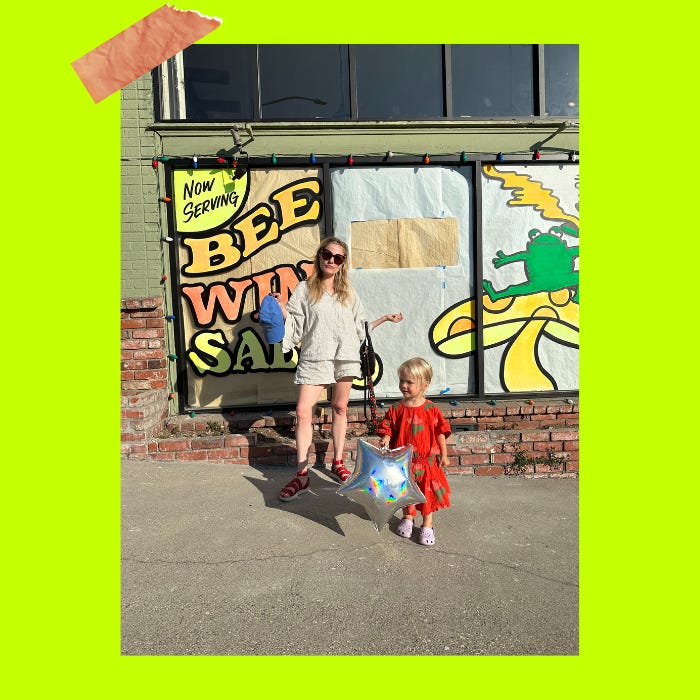Laid Off: When Tariffs Hit the Furniture World
"The design community reacted with extreme panic very quickly to this news and rightfully so."
Before we dive in… Laid Off hats are here. Did you get yours?
Hottest recessioncore hat of the summer just dropped
A few weeks ago, some cuties from the Laid Off Discord met up in Fort Greene Park to model the now shoppable Laid Off hats.
In today’s issue, I talk to Leonora Epstein on the ripple effects of tariffs in the furniture space and how her design Substack has become her creative anchor.
Leonora Epstein was laid off last month from her role as VP of Content & Creative at a luxury cabinetry startup.
“I knew I’d be the first to go,” she said, citing industry-wide tariff pressure and her understanding that creative is often first on the chopping block.
“Not having an income sucks,” Leonora said, adding that her husband, daughter and herself are probably moving in with her parents this summer. “But I'm trying to view it as an opportunity for a vibe shift for my career and for my daughter.”
Unlike her last four layoffs, this time she had a successful Substack. In the wake of the news, she turned to her newsletter, Schmatta, to share the update and tap her network. It worked. Freelance work rolled in, and she even saw a boost in paid subscribers. But she’s still looking for something steady to make ends meet.
“That said, it would be really hard to accept a full-time position if the employer said I couldn't continue doing Schmatta. I'd never do it during working hours, of course.”
Let’s start with the moment Trump announced the tariff hikes — what was your immediate reaction, and how quickly did things shift in your world?
I knew immediately that it was a big deal and potentially disastrous for the furniture industry. I texted my boss, "Are you seeing the news?" and she hadn't even heard yet. The design community reacted with extreme panic very quickly to this news and rightfully so. For example, the news dropped right as the CEO of RH was on an earnings call. Someone interrupted him to show him the tariff news, and he just said, "Oh shit." There's not a company in furniture or manufacturing that isn't struggling with this tariff mess.
A lot of folks outside those industries might not understand how vulnerable they are to these kinds of shifts. Can you explain how tariff hikes ripple through the design world - and who gets hit first?
It's almost impossible to manufacture a home good entirely in America. You see a lot of manufacturing happening in China, of course, but also in Vietnam and Cambodia which have seen increased tariffs. Even if you have a component of your product that is manufactured in the U.S., the raw materials to create that product may be sourced from a country like China, thereby increasing the production cost of the item.
What were some of the projects you worked on while you were there? Anything you were especially proud of?
Sadly, most of my projects never came to fruition — lots of technical obstacles as well as budget clamp-downs — but I did have a robust marketing and editorial calendar planned including a 10-part kitchen renovation guide as well a collaboration with "A Field Guide to American Houses" to work on a guide to selecting millwork for historic homes. However, during my tenure, we doubled our Instagram audience and maintained a hugely impressive engagement rate.
You shared your layoff in your design newsletter Schmatta — not the usual place for career updates. We’re seeing more people break that mold and post layoff news wherever their audience already is. Do you think this is part of a bigger shift in how people are choosing to show up online after a layoff?
My motivation for sharing my layoff on Schmatta was to see if it could generate any employment leads. My employers at Isla Porter found me through reading my Substack. My desire is to continue to work professionally within the design space and my audience — lots of interior designers and people in the trade — offers a built-in network. After posting, I had a really nice boost in paid subscribers… everything helps! But I also had people reaching out about opportunities immediately, which was wonderful.
When you lost your job in 2023, you launched Schmatta. This time around, you already had it. How did that change the whole experience of being laid off?
When I was first laid off in December 2023, I was VP & editor-in-chief of Hunker, a decor publication I co-founded. The media landscape was especially dead at that point, and I had literally zero leads for months. So I spent a lot of that time growing Schmatta. This time around, thanks to Schmatta, I've very quickly landed some freelance work and gigs, but nothing to really pay the bills yet, sadly. Substack, in my experience, is an amazing place where people really do communicate. My readers are so kind and engaged. Brands: If you are listening, I'll send you my media kit!
Did having a newsletter that people actually read soften the blow — or raise the pressure to suddenly make it your full-time thing again?
Having the newsletter is so important to me for staying involved in design and keeping my writing out there. Schmatta does generate some income through branded partnerships and paid subscribers, so I'm definitely spending more time than usual pursuing partnerships and thinking about how to grow the paid side. But I've never put pressure on the project. I love doing it and I'd do it even if it made zero dollars.
You’re part of what some are calling “design Substack,” and you’ve talked about its potential to change the media landscape. What makes this moment so ripe for a shift, and how are you thinking about your role in that change?
I think we’re at a tipping point where legacy design media can no longer keep up with how people actually consume, discuss, and participate in design and interiors. The rise in "design Substack" is reviving decor/design as a general interest category because it is detached from the constraints of traditional media — traffic goals, brand conflicts, etc. I think there is some larger future for design Substack, but I can't quite see what it is yet. I hope to be involved in it, whatever it is.
There’s a real shift happening in design media - and you’ve found yourself at the center of this scrappy movement on Substack. What’s the group chat energy like behind the scenes? Are people cheering each other on? Comparing open rates? Sharing trade gossip?
Design Substack people are fantastic. I have at least six other design Substackers in my phone that I can randomly contact for anything, even if it's just commiserating over low freelance rates. And yes, we do gossip about certain designers and brands.
Creatively speaking, what’s something you’ve gotten to do in Schmatta that you never could have pulled off in a traditional editorial job?
Schmatta allows me to publish stories that would never see the light of day in traditional publications. Such as "Fuck Decorating for Fall"; a takedown of paint companies' "Color of the Year" announcements; an exploration of "period" furniture (as in blood, not "of the era"); or a post written entirely from the perspective of the 2002 IKEA catalog.
So many people who get laid off wrestle with this tension: Do I double down on my own thing, or try to get back on someone else’s payroll? Where are you landing on that question right now?
I want to be on payroll. I need it. I don't have the financial resources to solely concentrate on Schmatta and even if I did, I'm not sure there's a world in which Schmatta can generate a solid six figures. I mean...that would be great. But career-wise, I have a great deal of experience and I enjoy being a creative who is also highly invested in the business side.
For others in media or design who just got laid off and are staring down a rocky market, what advice would you give, especially to those who haven’t built a side project like you have?
Open yourself up to other possibilities. If you're an editorial person, consider how you might pitch yourself as being valuable to a brand. And there's really nothing to lose in cold emailing companies you love. Also, read trade publications. I read Digiday, Business of Home, Brian Morrissey's newsletter.
Leonora would love to help any company as their head of content and/or marketing or as a brand director. She’s also open to freelance writing or projects. You can reach her on LinkedIn or through her website.
Gentle reminder: Laid Off is kept afloat by paying subscribers who support the work.
If you like this newsletter and have the means, consider becoming a paid subscriber. I appreciate you. Plus, at $5/month, you get access to the Laid Off Discord. We have fun.












